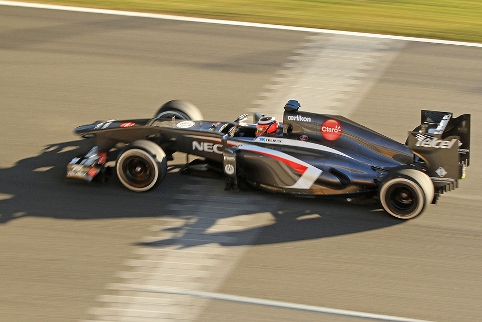Testing, it is a difficult and unpredictable beast, and is definitely an event you can quite easily read far too much in to if you are not careful. As the first pre-season winter test at Jerez draws to a close today, it does beg the question, is there really anything we can learn from this past week, or is it simply an event where we can just soak up the glorious sight of an F1 car back on a circuit for the first time in two months?
Well in a nutshell, I would say no essentially, nothing of any great bearing anyway, as the teams are simply shaking down and optimising their cars after unpacking them out of the box for the first time. Where we will start to really see where the land lies will be in Barcelona during the second test. It is considered one of the greatest tests in terms of aero balance and efficiency as well as chassis ability due to its wicked mix of direction changes, low, medium and high speed corners. Flaws with any of the team’s cars will be instantly highlighted round the Cataluyna circuit, and there will be essentially nowhere to hide from it – especially now Sky Sports F1 has declared they will be showing it live and in 3D.
So up to that point it is still pretty much guesswork, especially after the recent news surrounding the surface of the Jerez circuit being far too coarse for the new Pirelli compounds to be given a fair comparison, to their counterparts last year. This adds another dimension in that teams perhaps may not be getting the data, rubber wise that they feel comfortable with, and therefore it will make the Barcelona test even more important as they will have to kill two birds with one stone essentially, leaving less time to optimise chassis and suspension changes before the first race at Albert Park come March.
But can we take anything away from Jerez?
Well I don’t know about you guys, but there are definitely a couple of key interests that have caught my eye over the past four to five days including some controversial parts. The first of which is Caterham’s new exhaust solution that could potentially be borderline in terms of regulations. Within the exhaust exit channel itself there lies a very distinctive turning vane which is covered in a thermal coating. Of course at this point we do not know the full extent of its use; however it does look to be implemented within the channel to directly influence the hot gases exiting the exhaust. This of course increases the efficiency in which the airflow hits the floor and on to the diffuser.

Caterham’s exhaust design has drawn the attention of rivals during the Jerez test (Photo Credit: Octane Photographic)
It seems to have not been picked up by many in the paddock, but one man who has noticed the little feature has been Technical Director of Lotus F1 – James Allison, who questioned its legality when posed with a question and suggested that it may be removed by the first race of the year at Melbourne.
But the one car that really caught my eye was the Sauber C32; one which I feel will be incredibly strong throughout the season if development can be sustained at a relatively high pace. The design is of great intrigue to me, and it in many terms very different from any other car on the grid. The C32 is all designed around the principle of complete rear aerodynamic efficiency with the objective to achieve the least amount of restrictive elements on airflow over the car towards the rear.
By doing this they have made the sidepods 10-15cm narrower than last season, and have created an incredibly aggressive undercut to allow more airflow around the car towards the diffuser. This takes the principle of tightly packaged sidepods to the next level, to a point that no other team have tried. Of course incredibly small sidepods can potentially cause cooling issues, and radiator housing was a monumental hurdle to overcome with a distinctive lack of space according to Technical Director – Matt Morris.
Will it affect them? Well we will not find that exact answer out until we get to the hotter rounds at the start of the season, principally Malaysia and Bahrain where heat and humidity are at their highest at almost any point of the season, but so far through testing in Jerez there have been no major issues as of yet. Benefit’s wise, the sidepods offer the least possible resistance (or drag) towards the floor and rear of the car, meaning the scope to mould and manipulate the airflow around the exhaust area is greatly improved. The great advantage to this method if it works is that other teams will not be able to simply copy the design. The sidepods are intrinsic parts of the chassis and therefore a complete overhaul of the chassis would be necessary to implement something similar.

Sauber’s narrow new sidepods balance cooling issues with chanelling air towards the rear of the car (Photo Credit: Octane Photographic)
Of course this huge improvement in aero efficiency towards the rear of the car improves the balance and stability of the car at high speeds, and is something lead driver Nico Hulkenberg has already commented on since his first stint in the C32 during the week, complimenting the way the car felt through the high speed turns at Jerez, the Sauber car giving the German a lot of confidence whilst the laps went by.
The big test has yet to come though, Barcelona will separate the men from the boys, the good from the bad, and will give us the first glimpse of which team has really conquered winter development for the start of the 2013 season, are you excited? Because I am!
What do you make of the Caterham CT-03 and the Sauber C32?



